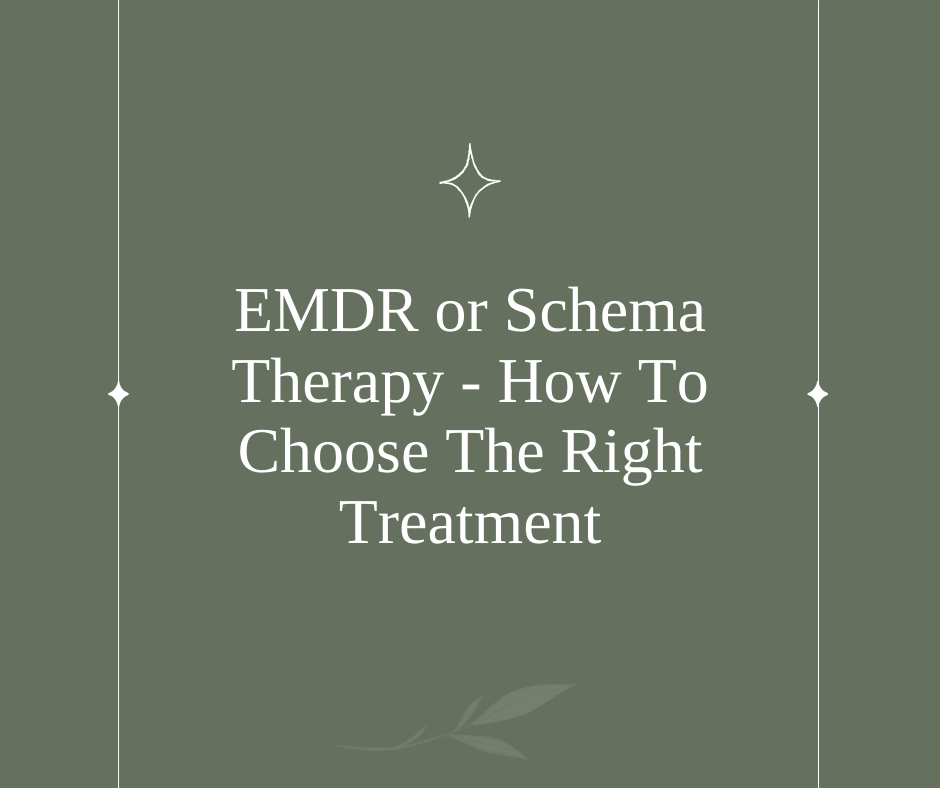I am trained in several modalities including Eye Movement Desensitisation and Reprocessing (EMDR) and Schema Therapy. The beauty of this is that I can draw upon a range of approaches at different points in your therapy journey. What I use and when will depend on your treatment needs and goals. Let’s explore these therapies in more detail…
What is EMDR Therapy?
Developed by Francine Shapiro in 1987, EMDR is an internationally recognised psychological therapy used in the treatment of trauma. It’s also used to treat other psychological difficulties such as anxiety disorders and depression.
EMDR uses what is known as bilateral stimulation (typically fast eye movements) to replicate the Rapid Eye Movement (REM) sleep phase. REM sleep helps our brains process the events and experiences of the day. EMDR mimics what your body naturally does when you are asleep, but you are completely awake and in control throughout the process. For more information, read All You Need to Know About EMDR.
What is Schema Therapy?
Developed by Jeff Young in the 90s, Schema Therapy is an integrative approach incorporating powerful elements from several therapeutic frameworks, including Cognitive Behavioural Therapy, Psychoanalytic Therapy, and Gestalt Therapy. In simple terms, Schema Therapy examines core themes within a person’s life to help them break negative, rigid and unhelpful patterns of thinking, feeling and behaving. To find out more, read What is Schema Therapy?
Do They Share Any Similarities?
Yes. They are both evidence-based trauma therapies and can be used to treat both PTSD and complex PTSD. EMDR is more suitable for single incident traumas (a one-time event), but it can be used to treat recurrent traumas. Both can and do focus on inner child work. Finally, they are both highly effective therapies that can treat the root causes of PTSD symptoms.
What Makes Them Different?
EMDR Therapy was developed to treat PTSD, whereas Schema Therapy was developed to treat Borderline Personality Disorder (or BPD), a diagnostic label that has historically been referred to as a ‘treatment resistant’ disorder. Schema Therapy can also treat chronic, longstanding issues that have their origins in childhood unmet needs.
Schema Therapy is more in depth. It examines the different parts that make up someone’s personality. For example, critic voices, where they come from and how to manage them. It’s particularly interested in the parts of us that developed in early life to protect us and help us survive. For example, we may have a part that tells us we need to shut our feelings off because they are too painful, or we may have a part that tells us we need to achieve the best in all we do to be accepted by others. These are called ‘psychological defences’ and they develop to help us survive extremely stressful and often neglectful environments.
Schema Therapy also involves ‘chair work’ where we might ask a part of the person to sit on a chair so we can hear from them. For example, a client may have a part that stops them from connecting with traumatic material. In this situation, I might ask the client to sit in a chair and talk to me from this part of themselves. I will ask them when and why they came into the person’s life. What are they scared will happen if the client connects with their pain? What will it take for them to trust me to hold space for the client and truly be there for them?
This process helps the client understand the different parts of themselves, why they developed, and the pros and cons of that part showing up in their life right now. Chair work is a main intervention in schema therapy. It can be used in EMDR, but it was not initially designed for this purpose.
Which Treatment Is Right for Me?
Often, during the trauma processing phase of EMDR Therapy, the processing can become blocked or stuck because the client has a psychological defence that shows up automatically. It does this to prevent them from connecting with the traumatic material. By shielding them from the distress this would cause, the defence also prevents them from processing the trauma.
If the psychological defences are very engrained and don’t shift through EMDR, I will often move on to using the Schema Therapy model. I will help the client identify when this part of them developed and why. Once we have this information, we can gently work with this aspect of them until it feels safe enough to step aside and let them connect with their traumas.
Although the way our brains automatically find ways to cope with extreme stress is fascinating, these defences that were protective in early life can prevent us from truly healing from trauma. Those who have heavily entrenched psychological defences often require significantly more time in therapy. For example, someone who was abused and repeatedly let down by their caregivers will take a long time to learn to trust others because their earliest experiences of doing so have been negative and abusive.
Find Out More
Both EMDR and Schema Therapy are focussed on helping you heal from trauma and improve your emotional wellbeing, but the journey to get there is quite different. If you’re still unsure which therapy is right for you, contact me to arrange a free consultation. I’d love to discuss the options with you.
Useful Links
Trauma – It’s Not What You Think It Is
